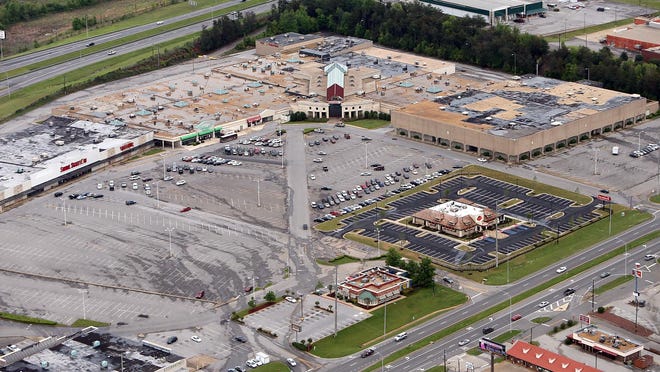Since it arose in 1969 on a previously underdeveloped area, McFarland Mall drew eyes, infrastructure development, hordes of shoppers and strollers, and eventually homebuyers. Its sheer mass and scope tugged the city of Tuscaloosa southward.
As just the sixth fully-enclosed mall in Alabama and biggest new kid in town, McFarland Mall siphoned retail from Alberta’s Leland Shopping Center and University of Alabama-adjacent Wood Square shopping center.
McFarland Mall initiated a drain from downtown Tuscaloosa. With its broad span of goods and services, entertainment and leisure choices, it became a de facto city center, but weather-proofed.
More:What does the future hold for Tuscaloosa’s once-thriving malls?
After more than 30 years in operation, during which the growing city added larger University Mall and other major shopping centers such as Midtown Village, McFarland Mall slowly became depopulated, then fell mostly defunct.
Major demolition began in 2014, and since then, the 38.6-acre site has been the center of massive “What if?” “How about?” and “Could we?” speculation.
Now it seems questions may soon be answered. Cassius Lanier, Tuscaloosa City Council representative for District 7, which contains the former mall, seems about to burst with news of a development, coming soon.
But about just what, he can’t yet say, until legal “T’s” get crossed, and “I’s” dotted.
“I’m not at liberty to speak about it, until everything gets finalized,” he said. “It’s about to be exciting.”
Creating something on the site was one of the major issues Lanier ran on, when he defeated Sonya McKinstry for the council seat in 2021.
“That’s really the thing that made me get in the race,” he said. “It’s going to increase some property values in this area. People who’ve built their homes there, they deserve this.”
More:McFarland Mall timeline: A look back at the rise and fall of a Tuscaloosa mall
Reached for comment, developer and site owner Stan Pate said there’s no news yet, but noted there’s “one lease left, so we have to wait on that to end,” referring to the Dollar Tree, the last physical piece of the old mall still standing.
“Mr. Pate and the City have had very positive and productive discussions over the past 90 days,” said Richard Rush, communications director for the city of Tuscaloosa. “The momentum is building, but there is still work to be accomplished. Clearly, there is a sincere desire by everyone involved to do something distinctive and transformative for this gateway.”
Lanier said negotiations among all parties are rolling along, adding “Mr. Pate has been a trouper.”
The big bend
On its grand opening Feb. 19, 1969, a $4.5 million project launched by Ward Wharton McFarland, a lawyer and real estate developer, McFarland Mall offered Gayfers and Woolco as anchors for an L-shaped structure holding 30 stores between, where you could buy books, music, electronics, diamonds, liquor, greeting cards, fabrics, appliances, furniture and furnishings, food and drink from Fair-Snak or Orange Julius, or groceries from Winn-Dixie.
As more additions soon joined, under its roof Tuscaloosans — and those driving from counties around with nothing like it — could find a thriving community, with larger spaces and chains moving in including Baskin-Robbins, Lee Roy Jordan’s Flaming Steakhouse, NGC Twin (movie) Theaters and the Swiss Colony. Spiller’s Pet Center, Chuck Collins Studio, Color Corner Photo Service, Jacobs Drug and Cafeteria, and Loft Candy piled on the offerings. The original mall opened up 379,000 square feet of retail-rental space, with 50,000 square feet for mall walking.
Its gravity spurred development on, around and beyond Skyland Boulevard, such that the area is no longer thought of as south Tuscaloosa. With completion of conjoined interstates 20 and 59 passing through, McFarland Mall sat at a juncture of three major thoroughfares, on Skyland and McFarland boulevards.
At its peak — with major expansions and renovations in 1980 and 1993, the former in response to the opening of University Mall at the intersection of 15th Street and McFarland — McFarland Mall grew to enclose 497,000 square feet, with four anchors, a 320-seat food court and atrium, 12-screen movie plex, and 40 stores.
Meanwhile, University Mall opened in 1980 with 733,254 square feet, though no movie theaters. And in 2004 development of the Hollywood 16 multiplex, further down Skyland, coincided with closing of McFarland’s Fox 12, one of the mall’s last big attractions.
More:Mallrat memories: Remembering when the mall was the place to hang out
The older mall remained viable and in the McFarland family until Pate bought it in 2009, but with the closures of Dillard’s and Goody’s, writing was on the wall. Demolition, with an eye to redevelopment, began in 2014.
Even though it’s now more rubble than retail, that crossing of I-59/20 over McFarland is still considered a gateway to the city. Crimson arches, adding structural support, were spun atop the adjacent interstate bridge in 2021 as part of an $83.4 million road widening and improvement project by ALDOT. Following Gov. Kay Ivey’s signature in May, the arches are officially named the Luther Stancel Pate III Memorial Bridge, after the developer’s late father.
Hopes, plans and proposals
In 2014, Pate announced a retail center plan called Encore Tuscaloosa, a proposed $75 million redevelopment, but that never came to fruition. In 2018, the city of Tuscaloosa negotiated to buy land from Pate, but struggled to find middle ground between appraisals: Pate’s had the mall site, and two other smaller properties, at about $47 million, while the city’s appraiser calculated them at about $24 million.
The summer after, based on an outside appraiser’s figures, and pushed by Councilor McKinstry, Pate had agreed to accept $23.5 million for the McFarland Mall site and a 27.4-acre mainly-wooded tract nearby known as the Moore property. But in 2020, the city’s finance committee killed the proposed sale. During those negotiations, a few developers made pitches, one for an open-air mall.
More:Could a return to community roots save declining malls?
McKinstry also proposed a plan called Invest 73, for the interstate exit nearby, a tax-free zone where qualified developments could earn tax breaks or rebates on new projects or existing site enhancements.
In 2021, Pate spoke of plans for an entertainment district anchored by a sports complex, potentially involving boutique stores, areas for food trucks, spaces for seniors to safely congregate, and possibly even a skate park.
What do you want to see at McFarland Mall?
With Thanksgiving, Black Friday and holiday shopping approaching, we asked readers for their wish list. Not shockingly for an open social media question, many responses seemed less than serious: UFO rest area; giant statue of Stan Pate; 300-foot monument to Jesus and the Bear with waterslides, rollercoasters, and beef jerky buffets; enormous vape and tattoo superstore; yearly Spirit store and broken, down-on-its-heels state fair once a year, with drag racing in between; and First Baptist Federal Prison.
Some yearned for specific retailers, such as Buc-ee’s, Costco, Top Golf, Rouses Supermarket, Trader Joe’s, Chili’s Nothing but Noodles, Shoney’s, Dippin’ Dots, Dave & Busters, Golden Corral Buffet & Grill, Shake Shack, Baskin-Robbins, K&G Fashion Store, Kohl’s, TGIFriday’s and Del Taco.
Realizing the long shot, others hoped for something nonprofit, a green space or other type of park. Others pondered a zoo, aquarium, convention center or women’s health-care center.
Some of the other dreams:
- Ronny Johnston: “A performing arts center for West Alabama, not one just for dance and theater at UA. Glad they’re getting it, but we need our own.”
- Patricia Holliman Goff: “A senior retirement high-rise complex with lots of green space and trees. Mixed in with shops and restaurants with a European flair.”
- Rebecca Todd Minder: “Youth athletic fields (because north and south Sokol are crazy packed) with a large dog park (because … again, the one we have is north of the river).”
- Lib Davis: “Affordable senior housing with senior center, shopping and greenspace. So many seniors are leaving Tuscaloosa. We need good affordable senior programs so more will stay. (Pate) might even get money from the Feds if it’s subsidized.”
- Cathy Newman: “I’d say I wouldn’t mind some more good restaurants, but there’s already so much elsewhere in town. Midtown is a traffic and parking nightmare though. My parents live near this site and there’s surprisingly little around for being right off the interstate. The park idea is interesting … but I guess a park with no trees …. “
- Milady Murphy: “A multifunctional design with restaurants, park/green space, affordable housing/condo/apartment area, along with an area for a grocery store/pharmacy. Making all of it walkable.”
- Keli Goodson Stiglich: “Event venue with ice rink so UA hockey doesn’t have to drive to Pelham constantly!”
- Jake Huggins: “I think it’d be awesome if they created something akin to another mall. With Amazon and other big internet stores, we’ve lost the magic of shopping amongst other strangers, enjoying an Icee or pretzel beneath the glow of neon lights, or seeing a movie on a hype Friday night. Who knows? Maybe, like music on vinyl, malls will return one day because of the experience it offers over online shopping. Whatever they do with the land, I think it’d be cool if it was something resembling a cool, updated mall.”
- Exa Johnston Skinner: “An urban farming center sort of like what is at Camp McDowell. Students and adult groups could learn about harvesting food and preparing fresh food, to help people understand how growing food saves money and is healthier. It could work in collaboration with Schoolyard Roots, Community Soup Bowl, and Table of Grace food pantry. It would help break up the area’s scenery of concrete and asphalt and provide a cooling element. It could provide neighborhood garden space for nearby communities and donate seeds to them. It could teach about farming methods that are safe for the earth, and partner with the wildflower society to have pollinator gardens of native plants.”
- Ria Evans: “Trees, greenspaces, and walking paths all around, with nice big tall open shady shelters… and a modular layout to host festivals, fairs, food trucks, vendors. You could have several stages to host music festivals, band competitions, and outdoor drama productions. Vendors and restaurants could all be pop-up or mobile. Always changing. The only permanent buildings could be nice restrooms. Or a big huge open air mall (a roof) like the French Market in New Orleans. An area for street performers and artists. The property would still be big enough to have some permanent amusements … like a go-cart track, putt-putt golf, or skateboard area. Heck maybe a Trader Joe’s or Costco at a corner too. Maybe have a drive-in movie theater for when there isn’t a fair or festival there?”
Reach Mark Hughes Cobb at mark.cobb@tuscaloosanews.com.
This post was originally published on this site be sure to check out more of their content.









